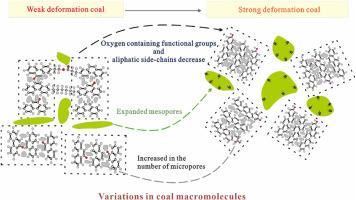Pore and chemical structure variation of tectonically deformed coal and their influences on methane adsorption
IF 5.5
0 ENERGY & FUELS
引用次数: 0
Abstract
Coal deformation involves the transformation of coal from its initial geometric state to its final state, encompassing rigid body translation, rotation, strain, distortion, and volume changes driven by factors such as embrittlement, fracturing, or ductile deformation. This study selected three types of tectonically deformed coal (TDC) from the Sanjiang-Mulinghe Basin Group—cataclastic, granulated, and mylonized—characterized by progressively increasing degrees of deformation, to evaluate their methane adsorption capacities and elucidate the underlying mechanisms driving the observed differences in adsorption capacity. The adsorption characteristics were examined using an isothermal adsorption apparatus employing the volumetric method. Nitrogen adsorption-desorption and CO2 adsorption techniques were utilized to analyze the mesoporous and microporous structure. X-ray diffraction and Fourier-transform infrared spectroscopy were performed to determine the basic structural units and organic molecular structure parameters in coal. The findings indicated that methane adsorption capacity progressively enhances across the cataclastic → granulated → mylonized deformation sequence in the TDCs of the Sanjiang-Mulinghe Basin Group, which is attributed to the deformation-induced expansion of available adsorption spaces and the strengthening interactions between coal macromolecules and methane molecules. The deformation of coal prompts the polycondensation and depolymerization of its macromolecular structure, leading to an increase in both pore volume and specific surface area of TDCs. This enhancement is particularly significant with higher degrees of coal deformation, offering additional space and adsorption sites for methane, thereby improving methane adsorption capacity. Concurrently, parameters such as crystallite size and aromaticity were found to increase with more intense coal deformation. The increase in crystallite size is due to the growth in the number of crystallites per stack, the height of the stacks, and the diameter of crystallites within a stack, accompanied by a decrease in the distance between aromatic layers. The study enhances comprehension regarding the gas-bearing characteristics of tectonically deformed coals.

构造变形煤孔隙化学结构变化及其对甲烷吸附的影响
煤的变形是煤从初始几何状态到最终状态的转变,包括在脆化、破裂或延性变形等因素驱动下的刚体平移、旋转、应变、变形和体积变化。本研究选取三江—木林河盆地群中变形程度逐渐增大的3种构造变形煤(碎裂煤、粒状煤和糜棱煤),对其甲烷吸附能力进行了评价,并阐明了吸附能力差异的机制。采用等温吸附仪,用体积法测定了吸附特性。采用氮气吸附-解吸和CO2吸附技术对其介孔和微孔结构进行了分析。利用x射线衍射和傅里叶变换红外光谱测定煤中的基本结构单元和有机分子结构参数。研究结果表明:三江—木林河盆地群TDCs的甲烷吸附能力在碎裂→粒化→糜棱化变形序列中逐渐增强,这是由于变形导致有效吸附空间扩大,煤大分子与甲烷分子相互作用增强所致。煤的变形促进了其大分子结构的缩聚和解聚,导致tdc的孔隙体积和比表面积增加。这种增强在煤变形程度较高时尤为显著,为甲烷提供了额外的空间和吸附位点,从而提高了甲烷的吸附能力。同时,晶粒尺寸和芳香度等参数随煤变形强度的增大而增大。晶体尺寸的增加是由于每堆的晶体数量、堆的高度和堆内晶体直径的增加,同时芳香层之间的距离减少。该研究提高了对构造变形煤含气特征的认识。
本文章由计算机程序翻译,如有差异,请以英文原文为准。
求助全文
约1分钟内获得全文
求助全文

 求助内容:
求助内容: 应助结果提醒方式:
应助结果提醒方式:


